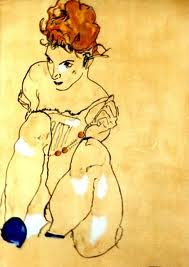I struggled with this final piece of work and for a number of reasons. Initially, this was set up on the window sill. The windowsill is 'white' and so is the jug containing the flowers. With the light of the glass behind, the whole composition would be very high key if I left the colour as it was, which I considered doing in shades of grey with a contrasting strong colour for the flowers. However as this is an exercise in colour I decided that this would be unsatisfactory and so started thinking about colour schemes.
I had decided upon colour pencil as detail was required and tried this on smooth Fabriano paper. However, the coloured pencils I use are Faber which are oil based and harder than other wax based pencils. Consequently, when I tried to depict the glass with large hatching strokes the whole thing looked too busy and was competing with the flowers.
Because of this I tried a quick sketch in different coloured inks with pen but found it too insipid so went back to my first choice of medium but decided to include watercolour pencils for the larger background areas and for some detail on the petals in order to try to gain a looser, transparent look. Consequently I used a watercolour paper to take the washes.
Before moving to my final choice as above and to overcome the lack of 'colour' I thought it would be interesting to try the drawing on grey pastel paper but this made the whole thing look too heavy. So as well as deciding on the coloured pencils I decided too that white paper would be best.
The next concern was the colour palette. I wanted to limit the colours but stay with the local colour of the flowers. As the flowers were drawn in a blue red I thought the tone on the window frame could be done in blue in order to keep a harmony. The jug was done in shades of brown for warmth and contrast and complements the blue as does the wall colour of a slightly lighter shade of brown. I was hoping that the colour of the jug would bring it forward but not detract from the focal point of the flowers. The background glass is done in a very weak blue wash over which I tried to hatch white colour pencil to create an effect of glazing. This was unsuccessful.
I'm not sure if the back of the window frame is correct?
Although aerial colour perspective suggests that colour should fade as subjects move away this part of the window was in the deepest shade. I've looked at this part of the work often but cannot decide whether or not the colour is too strong here.
For some reason I had it in mind that the object for this assignment was a vase of flowers and I became keen to portray the lilies. However having done much of the work I realised that other objects were meant to be part of the composition. And that the other objects should be 'found' as were used earlier. Considering this omission and how to rectify it was difficult as I thought the picture could look too cluttered. Also, because the lilies are fairly exotic looking I thought that English countryside items would look out of place- I did put one other object on the shelf and left it at that.
I hope that the perspective as well as the colour gives an impression of depth. The vanishing point was off the paper and I tried to work it out correctly which I thought important as I knew that buildings were coming up in the next part of the course.
Overall, I believe my work has improved during the course of this unit and I have learned a lot about colour theory and different media.















